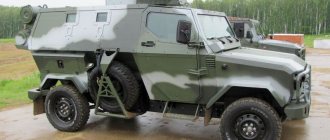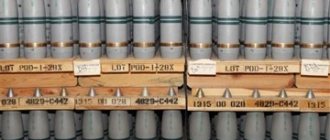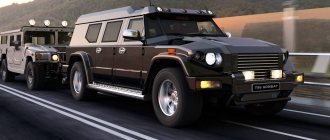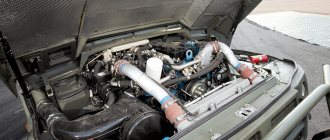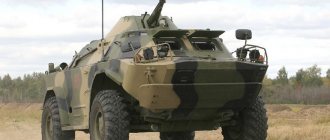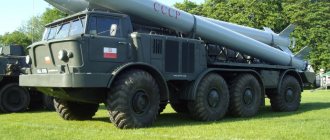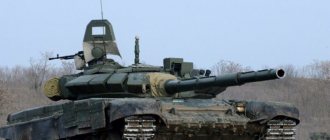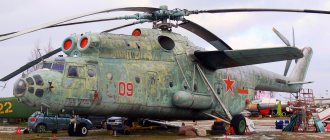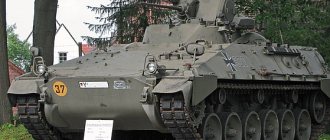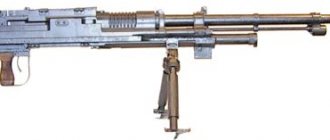BA-64 is a Soviet light armored vehicle. The most widespread and only serial Soviet all-wheel drive armored vehicle of the Great Patriotic War period, the BA-64 was developed on its own initiative by a group of specialists from the Gorky Automobile Plant under the leadership of lead designer V. A. Grachev. A GAZ-64 passenger car was used as a chassis, on which a fairly compact armored hull was placed for two crew members.
Armored car BA-64 - video
Design
The BA-64 had a layout with the engine and transmission compartment located in the front part of the vehicle, and the control and fighting compartments in the rear. The crew of the armored car consisted of two people: a driver and a commander, who also served as a turret gunner.
Armored hull and turret
The BA-64 had differentiated bulletproof armor protection. The armored body of the BA-64 was assembled by welding from rolled sheets of armor steel with a thickness of 4, 6, 9 and 12 mm on early production vehicles, and 4, 6, 7, 9 and 15 mm on all subsequent ones. In cross-section, the body had a hexagonal shape, all its surfaces were placed at angles of at least 30° to the vertical. The frontal part of the hull had a stepped shape and on the BA-64 it was formed by: an upper frontal sheet of the control compartment with a thickness of 12, on later production vehicles - 15 mm, placed at an angle of 40° to the vertical; the middle sheet, which served as the roof of the engine compartment, 6 mm thick and located at an angle of 84°, two lower frontal sheets 9 mm thick, located at angles of 30 and 52°. On later production machines, the two bottom sheets were replaced by one, located at an angle of 32°. The very bottom of the frontal part of the hull served for air intake to the engine and consisted of 6-mm overlapping armored louvres. The lower part of the hull side was made of armor plates 9 mm thick located at an angle of 30°, 7 mm on later production vehicles. The upper side sheets were also inclined at 30° and had a thickness of 6 mm in the area of the engine compartment and 9 mm in the area of the control compartment and fighting compartment. The rear of the hull consisted of a 9-mm top sheet, inclined at 30°, and a 6-mm bottom sheet, inclined at 35°. The bottom and roof of the hull had a thickness of 4 and 6 mm, respectively.
This level of armor provided the vehicle with protection from conventional 7.62 mm rifle bullets - from all distances, and armor-piercing bullets - only for the control compartment and fighting compartment. The upper frontal sheet protected from 12.7 mm conventional bullets at all distances, while the remaining frontal sheets protected only at distances of more than 500 m. Only the upper frontal sheet protected from armor-piercing 12.7 mm bullets, and only at distances of more than 800 m. BA-64B generally had the same hull shape, but the thickness of the lower frontal plate was increased to 11 mm, the thickness of the air intake louvers was increased to 7 mm, the air intake cover in the roof of the engine compartment was increased to 8 mm, and the lower aft armor plate was increased to 11 mm , while the thickness of the upper one was, on the contrary, reduced to 11 mm. In addition, the body of the BA-64B was made of armor steel grade 77, which was distinguished by greater bullet resistance. Boarding and disembarking of the crew on all modifications was carried out through two hatches in the lower sheets of the control compartment; in addition, the commander could carry it out through the top of the turret.
The turret of the armored car had an octagonal shape in the form of a truncated pyramid, open at the top. The walls of the turret were inclined at 30° and had a thickness of 9 mm on early production vehicles, and 10 mm on subsequent vehicles. The turret was placed on a rotating column, resting on the floor of the fighting compartment; on early production vehicles it had no connection with the hull roof, but on later production vehicles, four rollers resting on the roof were added to the turret to increase stability. The turret was rotated manually by pushing the arc that connected it to the supporting column. To fix it in the desired position, the turret was equipped with a hand brake-clamp. The top of the turret on early production vehicles could be covered with folding metal mesh, which was later removed, as well as a canvas awning for protection from bad weather. In addition, the turret height on later production vehicles was increased from 275 to 290 mm.
The main armament of the BA-64 was a 7.62 mm DT-29 machine gun
Armament
The main armament of the BA-64 was a 7.62 mm DT-29 machine gun. The initial speed when firing a light bullet was 840 m/s, and the rate of fire was 600 rounds per minute, with a combat rate of fire of up to 100 rounds per minute. The weight of the machine gun without magazine was 8.35 kg. The machine gun was installed in the front part of the turret on a turret, which allowed its vertical aiming in the range from −36 to +54°. At ground targets, the machine gun fired through a vertical embrasure; horizontal guidance, with the exception of the narrow sector provided by the embrasure, was carried out by turning the turret. To fire at air targets, the turret could be lifted by the top edge of the turret using a flywheel, which allowed its free rotation. The machine gun could also be removed for use outside the vehicle, for which it was equipped with a removable bipod.
To aim the machine gun when firing at ground targets, a standard diopter sight was used, which allowed targeted shooting at fixed distances of 400 m, 600 m, 800 and 1000 m. The maximum sighting range was 1500 m. When firing at air targets, a ring sight was used, the maximum reach of the machine gun was the height was 500 m. The machine gun's ammunition capacity was 1260 rounds in 20 disk magazines of 63 rounds each; on vehicles equipped with a radio station it was reduced to 17 magazines or 1071 rounds. In addition to the machine gun, for close defense the BA-64 was equipped with 6 F-1 fragmentation grenades, as well as the crew’s personal weapons, such as submachine guns.
BA-64D with a DShK heavy machine gun
Surveillance and communications equipment
The means of observing the terrain for the driver on the BA-64 were limited to a viewing hatch located in the upper frontal armor plate, in which, for observation in combat conditions, a periscope mirror viewing device with triplex protective glass and an internal armored valve, similar to that installed on the T-light tank, was installed. 60 and provided visibility only to the frontal sector.[34] On the BA-64B, two inspection hatches with armored flaps located in the upper side panels of the control compartment were added to this. The vehicle commander could conduct observation through the open top of the turret, or through the machine gun embrasure; In addition, two viewing slots with armored flaps, armored visors and protective triplex glass were placed in the side plates of the turret. On the BA-64 of later releases and the BA-64B they were replaced by mirrored periscope viewing devices, similar to the driver’s device.
Most of the BA-64s produced did not have any special means of external communication; only a minority of the vehicles were equipped with radio stations of various models. The BA-64 was equipped with radio stations of the RB-64-142200 model, or 12RP, which was close in characteristics to it. The BA-64B was equipped with a 12RP or 12RPB radio station, which differed from the first in the presence of a short tank-type antenna and a headset instead of a handset, which increased communication efficiency. Both variants of 12RP provided a communication range of 8-15 km from one place, depending on terrain conditions, in telephone and up to 30 in telegraph; while on the move, the communication range was reduced to 4 km, and operation of the radio station on the move in practice was only possible for 12RPB.
BA-64E - armored personnel carrier for six infantrymen
Engine and transmission
The power plant of the BA-64 was generally borrowed from the base GAZ-64. The armored car was equipped with an in-line 4-cylinder four-stroke liquid-cooled carburetor engine, model GAZ-MM. Having a displacement of 3280 cm³, the engine developed a power of 50 hp. With. at 2800 rpm. The BA-64 differed from the base car in changes in the design of the engine systems, which allowed it, if necessary, to run on low-grade gasoline and oils. The capacity of the BA-64 fuel tank was 90 liters. The BA-64B was distinguished by the installation of a boosted engine up to 54 hp. With. engine and a modified carburetor design.
The BA-64 transmission included:
— single-plate dry friction clutch; — manual four-speed (4+1) gearbox; — a mechanical single-stage transfer case that made it possible to disable the front axle; — two cardan shafts connecting the transfer case to the axles; - two bridges.
The transmission of all production BA-64s was identical, with the exception of the introduction in February 1943 of a gearbox locking mechanism, which prevented the simultaneous engagement of first gear and reverse gear.
Chassis
The BA-64 had a 4 × 4 wheel arrangement. The front wheel suspension consisted of two quarter-elliptic springs and a hydraulic shock absorber for each. The suspension of each of the rear wheels consisted of a semi-elliptical spring, two single-acting hydraulic shock absorbers and was equipped with a torsion bar lateral stability stabilizer. Since February 1943, two additional shock absorbers on the front wheels were added to the suspension, and the springs were also strengthened. The BA-64B was distinguished by an extended track, which increased the stability of the vehicle and made it possible to abandon the lateral stability stabilizer. In addition, from October-November 1944, its chassis was further strengthened.
The steering wheels of the BA-64 were front, the steering mechanism consisted of a globoidal worm drive and a double roller with longitudinal and transverse rods. BA-64 brakes are shoe brakes on all wheels, with a mechanical drive. In combat conditions, the wheels of the armored car were equipped with bullet-resistant tires of size 7.00-16″ of the “GK” type filled with sponge rubber, but they limited the maximum speed to 40 km/h, so in non-combat situations the BA-64 was equipped with conventional pneumatic tires of the appropriate size.
Armored car BA-64B: testing and operation
Tests and operation revealed a number of shortcomings of the armored car. The most significant was the overturning of the armored car when turning, which led to the creation of a new modification with a wider track. The armored car received a more powerful 54 hp engine. With. The new armored car received the designation BA-64B. At the end of May 1943, a decision was made to put the BA-64B into production and production of the modernized armored car was to begin in Gorky. But in June 1943, German aircraft subjected the Gorky Automobile Plant to a series of massive bombings, as a result of which the enterprise suffered serious damage.
BA-64 at the crossing of the Oder. (warbook.ru)
All this was reflected in the production of a new armored vehicle, the production of which was launched only in August 1943. Production of the BA-64 continued until 1946. A total of 3903 BA-64 and 5160 BA-64B were produced. Thus, the BA-64 and its modifications became the most popular Soviet armored vehicle and at the same time the last - in the future there was a transition to the creation of armored personnel carriers.
In addition to the mass-produced BA-64 and BA-64B, there were a number of experimental modifications. An attempt was made to strengthen the armament of the armored car by installing 12.7 mm instead of the DT-29. DShK heavy machine gun. But for this, the turret required major changes; in addition, the military was not satisfied with the small magazine capacity of 30 rounds, and the Gorky Automobile Plant refused to convert the armored vehicle into a belt-fed DShK, citing workload. As a result, the BA-64 with a heavy machine gun remained in a single copy.
Another option was an attempt in 1944 to rearm the armored car with a Goryunov machine gun, but due to the lack of a shoulder rest on this model, this idea was also not developed. An attempt was made to transform the BA-64 into an armored personnel carrier capable of transporting five soldiers. Some vehicles received improvised weapons in front-line conditions - there are examples of the BA-64 being equipped with an anti-tank rifle
Operation and combat use
USSR
The first BA-64s began to enter service with the troops in May 1942, and already in the summer of that year they took part in combat operations on the Bryansk and Voronezh fronts. The main disadvantages of the BA-64 in battle were its insufficient firepower, as well as the difficulty of evacuating a damaged and burning vehicle, which could cost the lives of the crew. At the same time, the armored vehicle, which was mobile, maneuverable and had relatively high maneuverability, performed well in reconnaissance raids, landing operations, and even when escorting and providing fire support for infantry. The BA-64 turned out to be especially effective when storming cities, thanks to the large elevation angle of the weapon, which made it possible to fire on the upper floors of buildings in street battles, which was not available for most other types of armored vehicles. In this role, they were widely used in offensive operations during the final period of the war, right up to the capture of Berlin.
Thanks to the same advantages, the BA-64 was also used to repel attacks by enemy aircraft on the move. Although the probability of shooting down an enemy aircraft with fire from a diesel engine was very small, its protective effect was beyond doubt - the enemy was deprived of freedom of maneuver at low altitudes, where an air attack on ground targets by firing from airborne cannons and machine guns is most lethal. Therefore, anti-aircraft fire from the BA-64 on enemy aircraft contributed to a significant reduction in losses among the troops it protected.
By the end of the Great Patriotic War, 3,314 armored vehicles of all types remained in the army, the vast majority of which were BA-64s of both modifications. After the end of the war, the surviving BA-64s were soon written off, and the service of the BA-64B in the Soviet Army also turned out to be relatively short-lived. They were mainly used as combat training, at least until 1953. Sometimes BA-64s were also used for operational communications or, after installing a powerful radio station, as mobile command posts. As training vehicles used to train crews of wheeled armored personnel carriers BTR-40 and BTR-152, the BA-64 was used even before the mid-1950s.
Other countries
During the war years, 81 BA-64s were transferred to the Polish troops, of which by June 16, 1945, 53 vehicles remained in service, all modifications of the BA-64B. In the post-war Polish army, BA-64s were part of the 5/25 state tank regiments, which each had one armored vehicle as part of a headquarters platoon. Also, part of the BA-64 was consolidated into platoons of three vehicles, assigned to the 1st, 3rd, 8th, 9th and 14th infantry divisions, which fought the UPA forces in southern and eastern Poland, but in In February 1948, these platoons were disbanded. After the reorganization of the armed forces in the early 1950s, BA-64s were used primarily as part of reconnaissance battalions of divisions, which included 5 armored vehicles of this type. At the end of the 1940s, after a reduction in the size of the armed forces, most of the Polish BA-64s were withdrawn from service, but in 1951-1952 another 55 BA-64Bs were purchased from the USSR, and on December 31, 1954 in the People's Army of Poland There were 97 armored vehicles of this type.
The Czechoslovak Army Corps received 10 BA-64Bs in 1943, from which one company of armored vehicles was formed. During the war, BA-64s were used in small quantities by German troops, both the Wehrmacht and the SS, mainly in police and security units. After the war, a number of BA-64s were transferred to the GDR, where they were used mainly as police cars.
BA-64-Z (winter) - photo of an experimental half-track snowmobile
Modifications
— BA-64 — the initial model of an armored car with a rotating turret with a DDT turret mounted on a GAZ-64 chassis.
— BA-64B — a modernized version of an armored car on the GAZ-67 and GAZ-67B chassis.
— BASH-646 — a staff version of an armored vehicle with various armored hull options.
- BA-64D (D - designation for DShK) - modification with a 12.7-mm heavy machine gun DShK. Sometimes designated as BA-64K or BA-64DShK.
— BA-64E — an armored personnel carrier for six infantrymen.
- BA-64V and BA-64G (sometimes called BA-64ZhD) - two variants of armored tires based on the BA-64, produced, respectively, by the Vyksa Metallurgical Plant and GAZ.
— BA-643 (sometimes called BA-64СХ) is an experimental half-track snowmobile based on the BA-64.
BA-b4G - with a regular chassis, but with reverse and four rollers with flanges
History of creation
By the beginning of the Great Patriotic War, the only light armored vehicle in production in the USSR was the BA-20M. Created in the mid-1930s on the basis of the GAZ-M-1 passenger car, the BA-20 had become outdated by 1941: its rear-wheel drive chassis did not provide sufficient maneuverability on rough terrain, and the armor, which protected only from non-armor-piercing bullets, did not meet the increased requirements in terms of security. Since 1941, due to the reduction in production of the GAZ-M-1 and the transition to the production of the new all-wheel drive vehicle GAZ-64, it was decided to transfer the light armored car to the base of the latter. Work on a new generation of armored vehicles that used an all-wheel drive chassis and a body with rational armor angles was carried out in the USSR in the pre-war years, but did not go beyond the creation of prototypes.
The idea of developing a new armored car was submitted on a proactive basis by GAZ designers after the start of the war. After approval from management, on July 17, 1941, the design bureau under the leadership of V. A. Grachev, work began on the future BA-64. Preliminary study of the layout of the armored car was carried out by F. A. Lependin. At first, it was planned to limit ourselves to transferring the armored hull and equipment of the BA-20 to the new chassis, but it soon became obvious that the level of its armor protection was insufficient, and the irrational shape and layout of the hull did not allow it to be strengthened without significantly making the structure heavier. In this regard, it was decided to develop a completely new design, focusing on pre-war prototypes such as the LB-62. The creation took into account the experience of the combat use of Soviet armored vehicles in the initial period of the war, and the designers were also influenced by the study of a captured German armored car, presumably Sd.Kfz.221, demonstrated at the Test Site of the BT Research Institute in Kubinka on August 23, and on September 7 transferred to GAZ for detailed study.
On September 16, a meeting was held at which the concept of a future armored car, called “64-B”,
. In addition to the design team, the chief designer of the plant, A. A. Lipgart, and his deputy for tank building, N. A. Astrov, who was involved in the development of small and light tanks, took part in it. As a result of the meeting, it was decided to create an armored vehicle with an extremely minimized reserved volume and a short body that only slightly protrudes in length beyond the frame. Another innovation was the introduction of sharp differentiation of armor protection. The internal layout of the armored car also turned out to be as compact as possible; in order to place the fuel tank in the rear part of the vehicle, which is least damaged in battle, we even had to move the driver’s seat onto the engine compartment, placing it on the gearbox. The future armored vehicle, in addition to the functions of command reconnaissance, communications and servicing reconnaissance groups assigned to the BA-20, due to its better cross-country ability, was also planned to be used for pursuing a retreating enemy, battle control service, combating enemy airborne troops or, due to its low weight, for use in its own airborne operations . The vehicle was also supposed to be used to provide air defense for tank and cavalry units, so its weapons had to be capable of firing at air targets.
GAZ-64
Development of an armored hull designated as GAZ-125
, was carried out by the plant's body specialists - B. T. Komarevsky, V. F. Samoilov, Yu. N. Sorochkin and G. A. Nosov, as well as the designer of the tank design bureau A. S. Maklakov, who was involved in the design of the armored car turret, and N. A Astrov, who provided consultation on the work.
On October 13 and 15, the first and second versions of the vehicle's layout were completed, after which the team began work under the leadership of the lead designer of the vehicle, G. M. Wasserman, who was engaged in processing the GAZ-64 chassis for the role of an armored car. The parts developed for the armored car initially received the index “64-E”
, and later, after modernization,
“64-Zh”
.
Despite the lack of experience of most designers, design progressed at a rapid pace. On November 24-27, the armored corps was assembled and demonstrated to Marshal K.E. Voroshilov, who then took control of the work on the armored car. Assembly of the prototype armored car began on December 5, and on January 9, 1942, the mostly completed prototype, under the control of Grachev, made its first trip, which was generally successful, with the exception of the revealed weakness of the suspension. At the same time, the turret, although not fully equipped, contrary to some sources, was already present on the armored car, having been first installed on it on December 12th. The armored car was received and the next day it was completed and demonstrated to Voroshilov.
continued for another month, and the weakness of the suspension, which repeatedly failed, reappeared. On February 17, the armored car was demonstrated to the People's Commissar of Tank Industry V.A. Malyshev in Moscow. At the same time, the final military designation for the new vehicle was approved - BA-64
. On February 21-23, the armored vehicle was tested in weapons at the Sofrinsky artillery range and the training ground of plant No. 8, and on March 3, along with the new T-70 light tank, the BA-64 was demonstrated in the Kremlin in front of government members, including I.V. Stalin. After carrying out all the necessary modifications, the BA-64 was accepted into service by the State Defense Committee decree of March 14. By a resolution of the Council of People's Commissars of the USSR dated April 10, 1942, Grachev was awarded the Stalin Prize of the third degree, simultaneously for the development of the GAZ-64 and BA-64 on its basis.
| Production of BA-64 and BA-64B, pcs. | ||||||
| Modification / Year | 1942 | 1943 | 1944 | January - May 1945 | after May 1945 | Total |
| BA-64 linear | 1770 | 779 | — | — | — | 2549 |
| BA-64 radio | 779 | 636 | — | — | — | 1352 |
| BA-64B linear | — | 191 | 1596 | 448 | ||
| BA-64B radio | — | 214 | 1404 | 420 | ||
| Total | 2486 | 1820 | 3000 | 868 | ||
Armored personnel carriers
BA-64E
- an armored personnel carrier (designated as an “airborne armored vehicle”) based on the BA-64.
Work on the BA-64E
began at GAZ back in September 1942 and was caused by a shortage of armored personnel carriers in the Soviet army.
Although it was obvious from the outset that the BA-64, with its narrow and cramped body, was ill-suited to such a role, it was the only wheeled armored vehicle in mass production at the time. Due to the workload of the design bureau with work on modifying the armored car, work on the armored personnel carrier was soon postponed and resumed only in the spring of 1943. The first prototype of the BA-64E, still based on the narrow-gauge BA-64
, was assembled on March 3 and had a landing compartment open on top in place of the fighting compartment, in which the infantrymen were located on two benches with their backs to the sides. Landing and disembarking of paratroopers was carried out through a door in the stern, and the sides of the troop compartment were extended by welding additional sheets that protected the soldiers when firing over them. The vehicle was armed with the same DT-29 machine gun, but placed on a turret above the control compartment. Tests of the prototype, as expected, showed it to be cramped and difficult to quickly enter and exit, which is important for paratroopers.
Work on the armored personnel carrier, however, continued, and on April 3 a second prototype was assembled, this time on the BA-64B
.
In addition, it was distinguished from the first version by the absence of a machine gun, which was considered unnecessary, and the extension of the sides, instead of which two weapon ports were added in the sides of the troop compartment, which were closed with lids. Work on the vehicle had a low priority and, given the workload of the design bureau with more important activities, progressed slowly, but, nevertheless, by the end of 1943, three prototypes were built, aimed at military testing. The tests, which continued from February to March 1944, gave a negative result and the adoption of the BA-64E into service was not recommended, although recommendations were also given for the further development of its design. Refinement of the armored personnel carrier continued until the end of the year, but it was never accepted for service. In total, according to various sources, from eight to eleven BA-64E were manufactured. On the recommendation of Marshal Ya. N. Fedorenko, a command and staff vehicle was developed on the basis of the BA-64E with the installation of a powerful radio station 12-RTM
.
According to some sources, the vehicle was given the designation BASH-64
or
BASH-64B
, but according to others, it was not official and was used only in literature. The BASH-64 received a positive assessment from the command, and the issue of putting it into mass production was considered, but due to the approaching end of the war and the uselessness of such a compromise vehicle in peacetime conditions, work on it was eventually stopped.
In addition to unfulfilled factory projects, conversions of the BA-64 were also carried out in units, mainly towards the end of the war. At the same time, the top hull sheets were cut off from damaged armored vehicles, and any suitable windshield was installed, resulting in a semi-armored command vehicle for 1-2 passengers.
Performance characteristics of the BA-64
Layout: classic Crew, persons: 2 Manufacturer: Gorky Automobile Plant Years of production: 1942—1945 Years of operation: 1942—1950s Number of produced, pcs.: 9110
Weight BA-64
— 2.36 tons
Dimensions BA-64
— Body length, mm: 3660 — Body width, mm: 1530 — Height, mm: 1900 — Base, mm: 2100 — Track, mm: 1240 — Ground clearance, mm: 210
Armor BA-64
— Armor type: rolled steel — Hull forehead (top), mm/deg.: 12 / 40° — Hull forehead (middle), mm/deg.: 6 / 84° — Hull forehead (bottom), mm/deg.: 9 / 30—52° — Hull side (top), mm/deg.: 6—9/30° — Hull side (bottom), mm/deg.: 6—7/30° — Hull rear (top), mm / deg.: 9 / 30° - Hull rear (bottom), mm / deg.: 6 / 35° - Bottom, mm: 4 - Hull roof, mm: 6 - Turret front, mm / deg.: 9 / 30° — Tower side, mm/degree: 9 / 30° — Tower stern, mm/degree: 9/30° — Tower roof, mm: open
Armament of BA-64
— Sights: diopter — Machine guns: 1 × 7.62 mm DT-29
Engine BA-64
— Engine type: in-line 4‑cylinder carburetor liquid cooling — Engine power, l. p.: 50
Speed BA-64
— Speed on the highway, km/h: 80 — Cruising range on the highway, km: 560 — Specific power, l. s./t: 21.2
— Wheel formula: 4 × 4 — Suspension type: leaf springs and hydraulic shock absorbers — Climbability, degrees: 36 — Wall climbability, m: 0.25 — Ditch climbability, m: 0.35 — Ford climbability, m: 0 ,9
Modifications
- BA-64
is the initial model of an armored car with a rotating turret with a DDT turret mounted on a GAZ-64 chassis. - BA-64B
is a modernized version of an armored car on the GAZ-67 and GAZ-67B chassis. - BASH-646
is a staff version of an armored vehicle with various armored hull options. - BA-64D
(D is the designation for DShK) - a modification with a 12.7 mm DShK heavy machine gun. Sometimes designated as BA-64K or BA-64DShK. - BA-64E
is an armored personnel carrier for six infantrymen. - BA-64V
and
BA-64G
(sometimes called
BA-64ZhD
) are two variants of armored tires based on the BA-64, produced, respectively, by the Vyksa Metallurgical Plant and GAZ. - BA-643
(sometimes called
BA-64СХ
) is an experimental half-track snowmobile based on the BA-64.
Description of design
The general layout of the vehicle was identical to the basic one. The armored hull, armament composition, power plant and transmission have not undergone any changes. The main difference between the BA-64-Z and the base vehicle was a completely new chassis.[1][2][3]
Chassis
The chassis of the vehicle is ski-tracked, with a steerable front axle with skis and a leading tracked mover designed by S. S. Nezhdanovsky. To install the propulsion unit, the transfer case, driveshafts, rear and front drive axles, front springs, shock absorbers, brake system, spare wheel and fenders were removed from the production vehicle[2][3].
A new front swing axle with one transverse spring and a spacer fork from a GAZ-AA truck was mounted on two additional cross members mounted on the frame of the armored vehicle. Two removable skis from the GAZ-60 half-track vehicle were hung on the axles of the front axle steering knuckles.[1][2][3]
The rear drive axle was borrowed from the GAZ-AA car and modified: the drive from an open propeller shaft with hinges on needle bearings (similar to the GAZ-64) was redesigned and new spring cushions were installed [2] [3].
The caterpillar propulsion unit, applied to one side, consisted of a special box-shaped section of the load-bearing ski with a width of 375 mm, pivotally (via supports with bearings) attached to the hub of the drive axle, as well as an upper drive wheel with eleven teeth mounted on the brake drum and four dual road wheels installed on the sides of the load-bearing part of the ski; the outer support rollers also served as guide wheels and were equipped with tension mechanisms. The machine's caterpillar tracks are double, large-linked, equipped with transverse plates 57 mm wide, made of strip spring steel and arranged vertically in the form of blades with a pitch of 196 mm. The tracks went around the skis from below along the road wheels.[1][2][3]
The original design of the caterpillar propulsion unit ensured extremely high maneuverability and reliability of movement on virgin snow due to the constant compaction of the top layer of snow by the load-bearing skis, pushed away by the track blades.[1][2][3]
